Cucumber Diseases: [Characteristics, Types, Detection and Treatment]
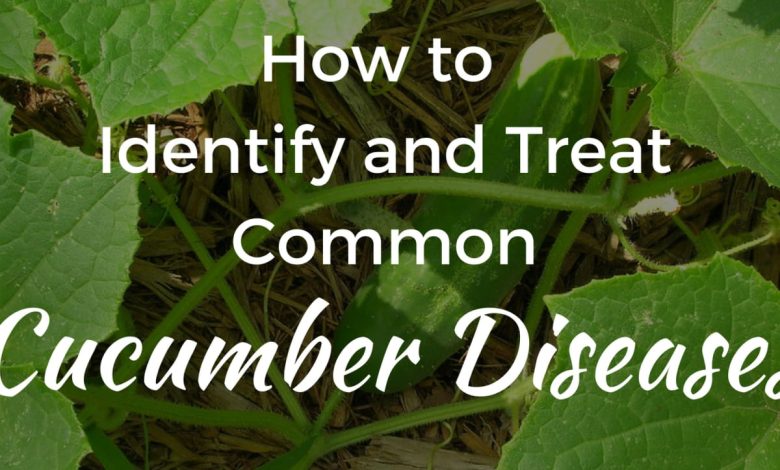
What are cucumber diseases and how can we detect them?
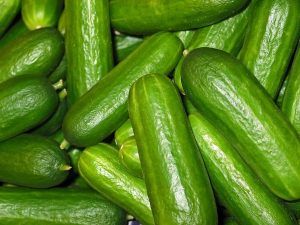 Cucumber belongs to the Cucurbitaceae family and is one of the most appreciated vegetables in world gastronomy, since it serves as both fresh and industrialized food.
Cucumber belongs to the Cucurbitaceae family and is one of the most appreciated vegetables in world gastronomy, since it serves as both fresh and industrialized food.
However, there are many diseases that attack this crop, some caused by parasites, fungi, bacteria and even viruses that cause serious damage to the plant.
One of the parasitic diseases that affects cucumbers is Oidiopsis, which appears as yellow spots on the upper side, causing necrosis in the center and showing a kind of whitish felt on the underside.
Among the cucumber diseases that are caused by fungi are: powdery mildew of cucurbits, mildew, Botrytis, white rot, gummy canker; Root and stem rot and Anthracnose that affect the leaves and flowers.
They also infect some cucumber crops such as Watermelon Necrotic Spot Virus type 1 and 2, Zucchini Yellow Mosaic Virus; Cucumber Mosaic Virus and Cucumber Yellow Vein Virus.
Viruses cause necrotic lesions and are seen as dark green spots along the veins of the leaves, smooth deformations on the leaf blade. They are generally combated by removing weeds and aphids.
When the cucumber is affected by some type of virus, it presents the yellowing of the veins of the leaves and a mosaic, light-green, dark-green, is produced in the fruits.
Description of cucumber diseases
Cucumber cultivation is attacked by the following diseases:
Oidiopsis
Caused by Leveillula taurica, which is a semi-internal development parasite whose conidiophores come out through the stomata, causing yellow spots and, in extreme cases, drying the leaves.
powdery mildew of cucurbits
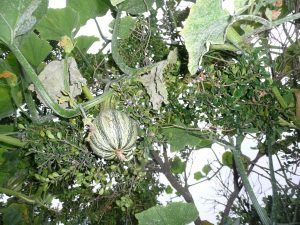 Also called «Ceniza» is a disease caused by Sphaerotheca fuliginea, which is spread by spores that are carried by the wind.
Also called «Ceniza» is a disease caused by Sphaerotheca fuliginea, which is spread by spores that are carried by the wind.
This fungus reproduces with favorable temperatures that are in a range of 10-35ºC, with the optimum around 26ºC.
Mildew (Pseudoperonospora cubensis)
This fungus is a parasite that needs free water to disperse its spores.The development of the fungus is favored by the alternation of hot temperatures. Night dews and morning mists also favor its development.
gray rot
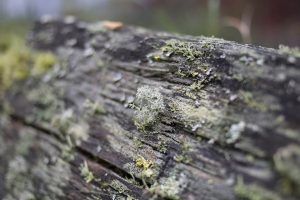 Caused by Botrytis cinerea, it attacks a large number of plant species, including cucumber, affecting all protected horticultural crops, being able to behave as a parasite and saprophyte.
Caused by Botrytis cinerea, it attacks a large number of plant species, including cucumber, affecting all protected horticultural crops, being able to behave as a parasite and saprophyte.
On cucumber leaves and flowers it leaves brown lesions. A soft rot (more or less watery, depending on the tissue) takes place in the fruits, in which the gray mycelium of the fungus is observed.
white rot
It is generated by the fungus Sclerotinia sclerotiorum that directly attacks the cucumber stem and generally causes the plant to collapse and die quickly.
The disease starts from soil sclerotia from previous infections, which germinate under conditions of high relative humidity and mild temperatures, producing a variable number of apothecia.
Gummy stem canker (Didymella bryoniae)
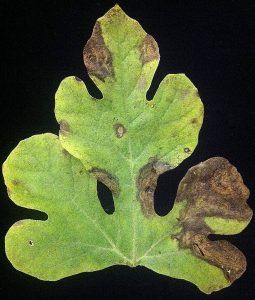 It directly affects the cotyledons, which end up drying out, producing lesions in the area where they join the stem.
It directly affects the cotyledons, which end up drying out, producing lesions in the area where they join the stem.
In cucumber cultivation there are attacks on the fruit, which are characterized by strangulation of the area of the stylar scar, which is covered with pycnidia.
Root and stem rot
Produced by Fusarium solani fs cucurbitae, which attacks the root and the base of the stem where a dark lesion can be seen that hangs the plant.
Anthracnose (Colletotrichum orbiculare)
It affects the leaves and flowers and can also cause lesions on the fruit.On the cucumber plant, moist brown spots are observed that spread throughout the leaf blade.It can attack both foliage and fruits.
How to identify and eliminate cucumber diseases?
Cucumber cultivation is of great importance, which is why it is necessary to know how to identify the conditions caused by bacteria, fungi and viruses to determine controls and methods to eradicate them.
Oidiopsis
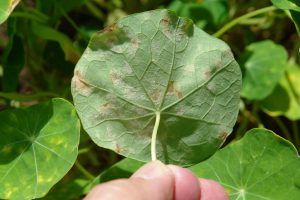 This parasite directly attacks the leaves and can be determined because it starts with yellow spots and then dries them up completely, causing them to fall off.
This parasite directly attacks the leaves and can be determined because it starts with yellow spots and then dries them up completely, causing them to fall off.
For preventive control of this disease, cultural techniques such as weed removal and use of healthy seedlings can be used.
When the disease becomes very strong, it is recommended to resort to chemical treatments with active ingredients: wettable sulfur, bupirimate, cyproconazole, ciproconazole + sulfur, among others.
powdery mildew of cucurbits
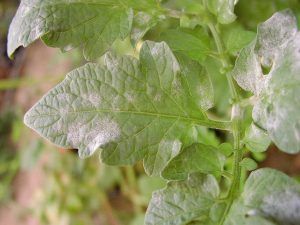 It is observed through white powdery spots on the surface of the leaves, it also affects stems and petioles and even fruits in very strong attacks.
It is observed through white powdery spots on the surface of the leaves, it also affects stems and petioles and even fruits in very strong attacks.
Weeds and other cucurbit crops, as well as crop residues, would be preventive controls and cultural techniques against this disease.
While among the chemical controls you can also see active materials based on sulfur, wettable sulfur, Bupirimate in concentrations of 0.2-0.3%; Cyproconazole 0-20g/hl and Triadimenol 0.02-0.04% PI.
Mildew
This disease manifests itself on leaves and stems with the appearance of white spots that turn dusty with an ash-like appearance when they develop.When the attack is severe, the plants become defoliated and production can be completely lost.
There are various cultural techniques that can be used to combat this disease, including the use of healthy seeds or plant material, not associating crops on the same plot, and using resistant or tolerant varieties.
Regarding chemical control, it must be carried out when there are plants with symptoms and when conditions are favourable, always using authorized active materials and applying the doses recommended by the technical staff.
gray rot
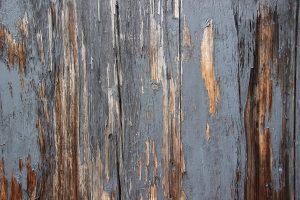 This disease attacks leaves and flowers but also cucumber fruit in which the gray mycelium of the fungus can be seen.
This disease attacks leaves and flowers but also cucumber fruit in which the gray mycelium of the fungus can be seen.
There are cultural prevention techniques such as the elimination of weeds, careful pruning, making clean cuts, applying fungicide paste, controlling nitrogen levels, among others.
Chemical controls require dosage and application that should be very careful based on active ingredients of Ciprodinil + Fludioxonil, Chlortalonil, Dietofencarb, or Fenhexamide.
white rot
This fungus produces sclerotia inside the stem and when it is mature it releases numerous spores, which mainly affect the petals.In the case of white rot, preventive techniques can also be used, such as the elimination of weeds, crop residues and infected plants; solarization and management of ventilation and irrigation.
In addition, chemical control can also be used with active ingredients such as azoxystrobin, ciprodinil, chlorthalonil, diethofencarb, fenhexamide, Iprodione, kresoxim methyl and Tebuconazole in the concentrations indicated by experts.
Gummy stem canker
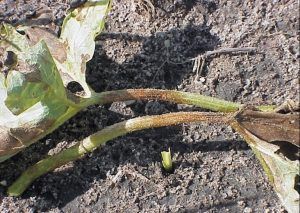 The most frequent symptoms in cucumber are characterized by a beige lesion on the stem, covered with pycnidia and often there are gummy exudations close to the lesion.
The most frequent symptoms in cucumber are characterized by a beige lesion on the stem, covered with pycnidia and often there are gummy exudations close to the lesion.
Points of infection in wounds as a consequence of pruning and grafting are frequent.
For preventive control, it is recommended to use healthy seeds, eliminate crop debris both around and inside the greenhouses, disinfect the greenhouse structures and ventilate, avoid excess soil moisture.
Root and stem rot
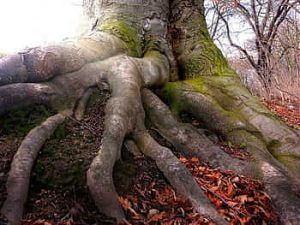 This disease occurs from the root and covers the entire stem, observing a dark-colored lesion that covers and hangs the plant.
This disease occurs from the root and covers the entire stem, observing a dark-colored lesion that covers and hangs the plant.
Treatments to combat this disease have to do with preventive techniques but fundamentally with the control of irrigation, since its excess can kill the plant.
It is also recommended to perform chemical treatments with thiophanate methyl active ingredients; carbendazim; propamocarb and prochloraz.
anthracnose
Symptoms can be clearly seen on young tissue by wet spots spreading across the brown leaf blade.It is recommended to use some chemical products preventively to combat anthracnose, among them: prochloraz; carbendazim; copper hydroxide and benomyl.
Bibliography and references
- virtuallibrary.com. Cucumber. Reproduced from: http://www.mag.go.cr/bibliotecavirtual/F01-0658pepino.pdf. (PDF)
- Juntadeandalucia.com. Pepino-Junta de Andalucía. Reproduced from: https://www.juntadeandalucia.es/export/cdn-micrositios/documents/71753/92810/Pepino/913e46dd-1572-4409-8de7-7db57268fd25?version=1.0. (PDF)
- Infoagro.com. Cucumber cultivation Part II. Reproduced from: https://www.infoagro.com/documentos/el_cultivo_del_pepino__parte_ii_.asp
- phytoma.com. Cucumber, pests and diseases. Reproduced from: https://www.phytoma.com/sanidad-vegetal/avisos-de-plagas/pepino-plagas-y-enfermedades-marzo-2017
- Blond Bernard. Cucumber cultivation technical guide. Reproduced from: https://silo.tips/download/guia-tecnica-del-cultivo-de-cucumber-i-nombre-comun-pepino-nombre-cientifico-cucum

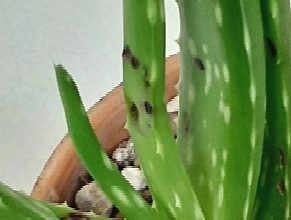

![Photo of Indoor Plant Care: [Soil, Humidity, Pruning and Problems]](https://www.complete-gardening.com/wp-content/uploads/2022/08/indoor-plant-care-soil-humidity-pruning-and-problems-390x220.jpg)
![Photo of Sulfur in Plants: [Use, Advantages, Excesses and Deficiencies]](https://www.complete-gardening.com/wp-content/uploads/2022/08/sulfur-in-plants-use-advantages-excesses-and-deficiencies-390x220.jpg)